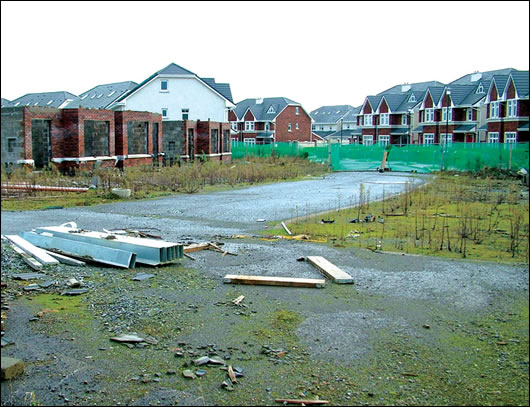- Blogs
- Posted
Ghost estates manual pays lip service to sustainability

By Sadhbh Ní Hógáin
Managing and Resolving Unfinished Housing Estates is a consultation manual published by the Department of Environment late last year. It identifies unfinished housing estates and outlines the health and safety issues surrounding these unfinished developments.
The report says that the over-supply in key metropolitan areas is not extensive and should improve in the short to medium-term. However, part completed or part occupied developments in areas with a weaker housing market may prove problematic.
The main proposals outlined are to complete unfinished housing estates identified by the National Housing Development Survey, ensure compliance with health and safety legislation and identify the roles and responsibilities of key stakeholders.
The report proposes that a team from each local authority maintain an up to date register of housing developments. This is a positive step, but the key responsibilities of the team should be widened to include the environmental assessment of housing developments.
While it is a positive step by the department to ensure the health and safety of unfinished housing developments, it is important to consider the long-term sustainability and environmental impact of finishing these estates. The report’s main aim is the “delivery of sustainable communities...and sustainable development...”, however there is no definition of sustainability. The three pillars of sustainability — the environment, the society and the economy — should be outlined and used as a basis to evaluate unfinished housing estates. The environmental impact of unfinished housing developments should be considered in terms of promoting sustainable living. A review of demand for housing, the existence of adequate local public transport and the availability of jobs and amenities within a locality are key to sustainable living. No alternative solutions are proposed for sites in areas with a weaker housing market.
The site resolution plan for problematic developments in areas with a weaker housing market should be extended to include the wider environmental impact of completing these developments. For problematic sites the focus should be promoting sustainable solutions. Although the environmental cost of demolishing a development may prove high in the short-term, the long-term environmental cost of completing developments in areas with low housing demand, poor local employment and poor public transport outweighs the short-term cost. This analysis should be included in the forward planning section of the report to promote sustainable low energy communities.
The report’s proposals are based on the National Housing Development Survey (2010). This survey was crucial to identifying unfinished housing estates. However, the report should extend this survey to include technical surveys of all unfinished estates. These surveys should include a review of services, access, safety, structural defects and a review of the quality of the housing stock with a focus on energy and carbon. This survey should focus on developments in areas with a weaker housing market to determine the value and viability of completing them.
Based on the extended survey a cost-benefit analysis should be carried out. This analysis should be used to evaluate the cost of completion — including upgrading the dwellings to a low energy standard — versus demolition of these developments. The analysis should include provision of adequate local public transport, the provision of amenities and the existence of a local job industry. Demolition of sites should be carried out where sites do not satisfy this analysis.
The report is a positive step to ensuring the health and safety compliance of occupied and part occupied unfinished housing developments. However, it would be enhanced if it examined the environmental impact of these developments. The report would also benefit from a detailed cost-benefit analysis which should include the economic, social and environmental costs of completing developments with particular focus on areas with weak housing demand.
Sadhbh Ni Hogain is a structural engineer working at EOS Future Design. She recently completed a MSc in advanced environmental and energy studies from the Centre For Alternative Technology, Wales.

